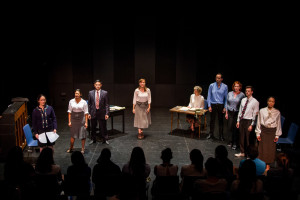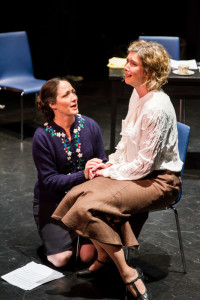Promising young composers’ musical about Rachel Carson reveals her triumphs, struggles, and the love of a woman who stood by her through it all
The primary reason I came to New York City this summer was to see Rachel: The Musical, currently being produced as part of the Fresh Fruit Festival at the Wild Project in NYC’s East Village. The show, written by young and promising brother-sister duo Jessie Field and Jared Field, tells the story of environmental pioneer Rachel Carson, and shares a side of her that the public never knew.
For the last decade of her life, Rachel Carson had a deep friendship, and likely romantic relationship, with her neighbor Dorothy Freeman. Their love sustained her through her creative struggles as an author, the challenge of adopting her nephew after his mother’s death, and at the end, the ravages of cancer. The musical wisely makes their relationship the heart of the piece, and through it shows how much Rachel had to risk, and sacrifice, to write her groundbreaking book Silent Spring and take on the chemical companies.
The role of Rachel Carson is split into two, with Erin Fish as adult Rachel and Rachel Flynn portraying her as a young woman. This division strengthens the piece, allowing it to shift back and forth in time without confusing the audience. Both incarnations sometimes appear on stage at once, and sing together. Other characters interact with Rachel at different points in time simply by moving across the stage. Such an arrangement could fail without careful attention to casting, but both actresses were well chosen. Flynn is optimistic, yet not too naive as she battles sexism in her chosen profession and finds her path as a writer. Fish uses her powerful singing voice to convey the older Rachel’s determination to live life outside the box and leave a lasting legacy despite the great personal cost of taking a stand.
Tamra Hayden as Dorothy Freeman is the heart of the piece. Dorothy was initially a neighbor of Rachel’s, and a fan of her books. A simple letter welcoming Rachel to the neighborhood grew into a decade long relationship between kindred spirits who loved nature and found comfort and understanding in each other. Hayden brings subtlety and complexity to her role as a woman who spent years following all the rules that Rachel broke, and through her discovered there was so much more to life. Her gradual realization of the depth of her love for Rachel is revealed in simple yet key moments throughout the piece, from her initial nervous pulling away when Rachel attempts to embrace her, to her final and unequivocal demonstration of love at the end. Hayden touchingly conveys the struggle of loving someone whose creative drive is both a blessing and a torment, and the feeling of loss when that person grows distant in pursuit of a cause that could cost them everything. The audience never loses compassion for her, even as we stand by Rachel while Dorothy works through her own pain.
A wonderful supporting cast rounds out this promising new show. Anette Michelle Sanders brings a quiet dignity to her role as Rachel’s loving mother, Ann Flanigan is heartfelt as mentor Mary Scott Skinker, and Lipica Shah provides great comic relief as Rachel’s relentlessly supportive literary agent (and a contrasting yet equally strong type of woman) Marie Rodell. Roberto Araujo also brings humor to his role as the sleazy chemical company guy.
The production is simple, with most of the sets involving only chairs and tables. The use of two desks on stage was particularly well conceived, with various scenes showing Dorothy and Rachel writing to each other, and young and older Rachel writing a different points in her life. The intimate setting of the small theater brings the audience closer to the characters. This is Rachel’s first fully staged production, and for a show that is still early in its development, it feels remarkably complete. The music is beautiful and complex, the lyrics often evocative, and drawing well from their beautiful source material such as letters between Dorothy and Rachel. Field and Field are young writers with remarkable talent, not just for their age, but for any age. Of course there are a few small bits and pieces that will surely evolve and grow, but I feel hopeful that we’ll see Rachel on Broadway one day. I plan to do everything I can to help make that happen.
I believe that this show is particularly important right now, while we as a society are engaged in the process of rapid growth and change in our attitudes towards same-sex relationships. Since their letters were published in 1994, there has been much question and debate about whether Rachel and Dorothy had a lesbian relationship. In some ways, I don’t think that’s a question we can fully answer, because the world was such a different place then. We do know that they destroyed some of their letters before Rachel died, and the many that survive show a deep and enduring passion.
Just a few weeks ago, the Supreme Court ruled that marriage is a right that belongs to all couples. The world has changed for the better very quickly, but in our rush to embrace equality, we must remember that not so long ago, things were very different. It’s hard for us to imagine now, but in 1955, around the same time as Rachel and Dorothy began their correspondence, a small group of brave women led by Del Martin and Phyllis Lyon started the Daughters of Bilitis, the first lesbian organization in the United States. It was the first and only space for women to feel safe exploring their feelings, and speak up for the most basic of rights, such as being able to dance with each other in a bar without risking arrest. Their reality was a world apart from that of mainstream, middle-class Rachel and Dorothy. Many of the women who chose to be out lived on the margins of society. Those who had careers and families hid in the closet, afraid of being ostracized. What little the general public knew about lesbians was broadly stereotypical; they were seen as mentally ill, societal outcasts, and worse.
There is no reason to believe that Rachel and Dorothy would have had access to more information about the diversity of lesbian identities and relationships. They may have looked at themselves and felt that they couldn’t be lesbians, because they didn’t fit the stereotypes. They were two women in love, but theirs must be a different category altogether. They didn’t have Ellen to make them laugh on daytime TV. They didn’t have Rachel Maddow to speak out about important issues. There were no respected bisexual people, no one to say that it’s possible to love more than one person at once. These concepts were foreign, even horrifying to polite society. Rachel and Dorothy had no frame of reference with which to understand their relationship or put it in context. They had only their feelings, which defied any categorization available to them in that era. And if those feelings had become public knowledge, it would have destroyed Rachel’s career.
Some scholars try to discount the idea of them having a lesbian relationship because Dorothy was married, and appeared happily so. However, in the 1950s and before, when Dorothy and Stan met, there was tremendous pressure for women to be married. You were considered an old maid, an object of pity and derision, if you did not marry. In fact, Rachel Carson faced criticism for not being married. Without a husband, children were out of the question. It’s possible that Dorothy married Stan because they were good friends; perhaps like many women of the time, she didn’t expect that passion and sexual desire would be a part of her marriage, and didn’t know that anything was missing until she met Rachel. Perhaps she was bisexual and loved both Stan and Rachel in a romantic way. All evidence suggests that Stan was understanding and supported them. He wasn’t threatened by Rachel; he appreciated their relationship and wanted his wife to be happy. That Rachel and Dorothy were able to express their affection as fully and passionately as they did is a testament to the depth of their love. They experienced what so many still struggle to accept today; love that is love. It transcends gender, and age, and sex. Their love was of the soul, and in the end that is the only love that matters.
On a more personal note, this show has a particularly strong resonance for me. Their relationship is the first time I have seen a reflection of the way I love. I’ve always been drawn to the written word, to its power to express feelings that I struggle to say out loud. Exchanging letters, or these days, emails, with someone creates an intimacy, a bond that can reach deep into the soul. I’ve had a few friendships or loves that don’t fit neatly into either of the boxes into which we try to place human relationships. They have been the most precious and treasured relationships of my life. This kind of love is rarely portrayed on stage, or anywhere else.
I am a creative person, and drawn to be a supporter of creative souls, so I relate to both Dorothy and Rachel. I’m an activist, I write, and want to have my voice heard in the world. Sometimes I feel like I’m shouting into the void and no one hears. It’s a lonely place to be. I am also deeply compelled to support musicians and artists, purely out of love for them and their work, and sometimes at the expense of my own heart. The creative process can be lonely, and heart wrenching, but also full of humor and joy. Being a support through all aspects of that journey is what I live to do, and it feeds my own creativity and soul, too.
When we look at people who have done great things in the world, whether they be musicians, artists, scientists, or activists, they have the names that we know and remember, but they weren’t alone. They had family, friends, loved ones, at least one person somewhere who believed in them and held them up during the difficult moments. Those people don’t get credit, nor do they often want it. Just knowing that they helped someone they cared about, and having the devotion and appreciation of those they have helped, is enough. Rachel had her Dorothy and our Earth is a better place because of them both. I’m so glad that their story is being told for many more people to hear.
If you are in the NYC area, you have 2 more chances to see Rachel: The Musical, tonight, July 22 at 8:30pm, and Saturday, July 25 at 2pm. More information here: Fresh Fruit Festival Don’t miss it!
457 , 1











Great great article ……. what a wonderful writer you are… beautifully written.